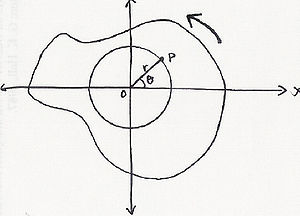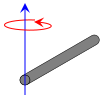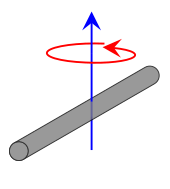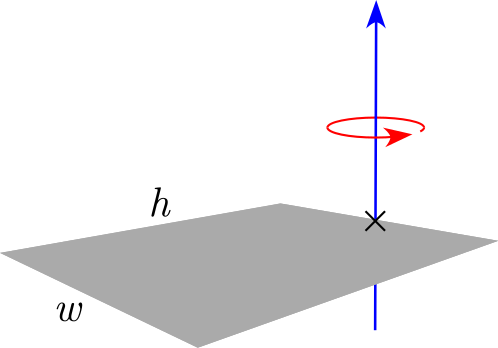Physics equations/Impulse, momentum, and motion about a fixed axis
Impulse and momentum
[edit | edit source]Impulse is denoted by the symbols I (which is too easily confused with moment of inertia), or Imp, or J (we shall use the latter):[1]
Momentum (or linear momentum) is:
Total linear momentum is an extrinsic and conserved quantity, provided the net external force is zero. It can be shown that momentum obeys (d/dt)Σp=ΣFext. Kinetic energy and momentum are related by,K=½mv2=p2/(2m). Linear momentum is related to linear momentum by the impulse-momentum theorem:
From Newton's second law, force is related to momentum p by
- . Therefore,
Torque
[edit | edit source]

Torque, moment or moment of force is also called moment. The symbol for torque is typically τ, the Greek letter tau. When it is called moment, it is commonly denoted M.[2] The SI units for torque is the newton metre (N·m). It would be inadvisable to call this a Joule, even though a Joule is also a (N·m).
More generally, the torque on a particle (which has the position r in some reference frame) can be defined as the cross product:
where r is the particle's position vector relative to the fulcrum, and F is the force acting on the particle. The magnitude τ of the torque is given by
where r is the distance from the axis of rotation to the particle, F is the magnitude of the force applied, and θ is the angle between the position and force vectors. Alternatively,
where F⊥ is the amount of force directed perpendicularly to the position of the particle and r⊥ is called the lever arm.
Rotational motion about a fixed axis
[edit | edit source]
Angular displacement may be measured in radians or degrees. If using radians, it provides a very simple relationship between distance traveled around the circle and the distance r from the center. [3]
A particle moves in a circle of radius . Having moved an arc length , its angular position is relative to its original position, where .
In mathematics and physics it is usual to use the natural unit radians rather than degrees or revolutions. Units are converted as follows:
An angular displacement is described as
Angular speed and angular velocity
[edit | edit source]Angular velocity is the change in angular displacement per unit time. The symbol for angular velocity is and the units are typically rad s−1. Angular speed is the magnitude of angular velocity.
The instantaneous angular velocity is related to particles speed by
where is the transitional speed of the particle. A changing angular velocity indicates the presence of an angular acceleration in rigid body, typically measured in rad s−2. The average angular acceleration over a time interval Δt is given by
The instantaneous acceleration α(t) is given by
Kinematic equations of motion
[edit | edit source]When the angular acceleration is constant, the five quantities angular displacement , initial angular velocity , final angular velocity , angular acceleration , and time can be related by four equations of kinematics:
Kinetic energy
[edit | edit source]
The kinetic energy of a rigid system of particles moving in the plane is given by[4]
Thus, where is called the moment of inertia.
The moment of inertia of a continuous body rotating about a specified axis is calculated in the same way, with the summation replaced by the integral,
Here r is the distance to the axis and ρ=ρ(r) is the mass density. As shown above, this can be converted into a line, surface, or volume integral for a substance with a surface mass density ρ(x,y) or line mass density λ(x)
Torque, angular momentum, and work
[edit | edit source]The rotational equivalent of Newton's ,F = ma, linear momentum as, p = mv, and work as W = FΔx → ʃFdx, is , , and , respectively.Here, L is angular momentum, which does not have the same units as linear momentum. But work, W, is measured in the same units (Joules).
Moments of inertia for simple geometries (hidden table)
[edit | edit source]| Description[5] | Figure | Moment(s) of inertia |
|---|---|---|
| Point mass m at a distance r from the axis of rotation. | ||
| Two point masses, M and m, with reduced mass and separated by a distance, x. | ||
| Rod of length L and mass m (Axis of rotation at the end of the rod) |

|
|
| Rod of length L and mass m | 
|
|
| Thin circular hoop of radius r and mass m | 
|
|
| Thin cylindrical shell with open ends, of radius r and mass m | 
|
|
| Solid cylinder of radius r, height h and mass m | 
|
|
| Sphere (hollow) of radius r and mass m | 
|
|
| Ball (solid) of radius r and mass m | 
|
|
| Thin rectangular plate of height h and of width w and mass m (Axis of rotation at the end of the plate) |

|
|
| Solid cuboid of height h, width w, and depth d, and mass m | 
|
- ↑ //en.wikipedia.org/w/index.php?title=Impulse_(physics)&oldid=580814154
- ↑ https://en.wikipedia.org/w/index.php?title=Torque&oldid=582917749
- ↑ https://en.wikipedia.org/w/index.php?title=Angular_displacement&oldid=575169747
- ↑ https://en.wikipedia.org/w/index.php?title=Moment_of_inertia&oldid=583286938
- ↑ https://en.wikipedia.org/w/index.php?title=List_of_moments_of_inertia&oldid=582953751




















































